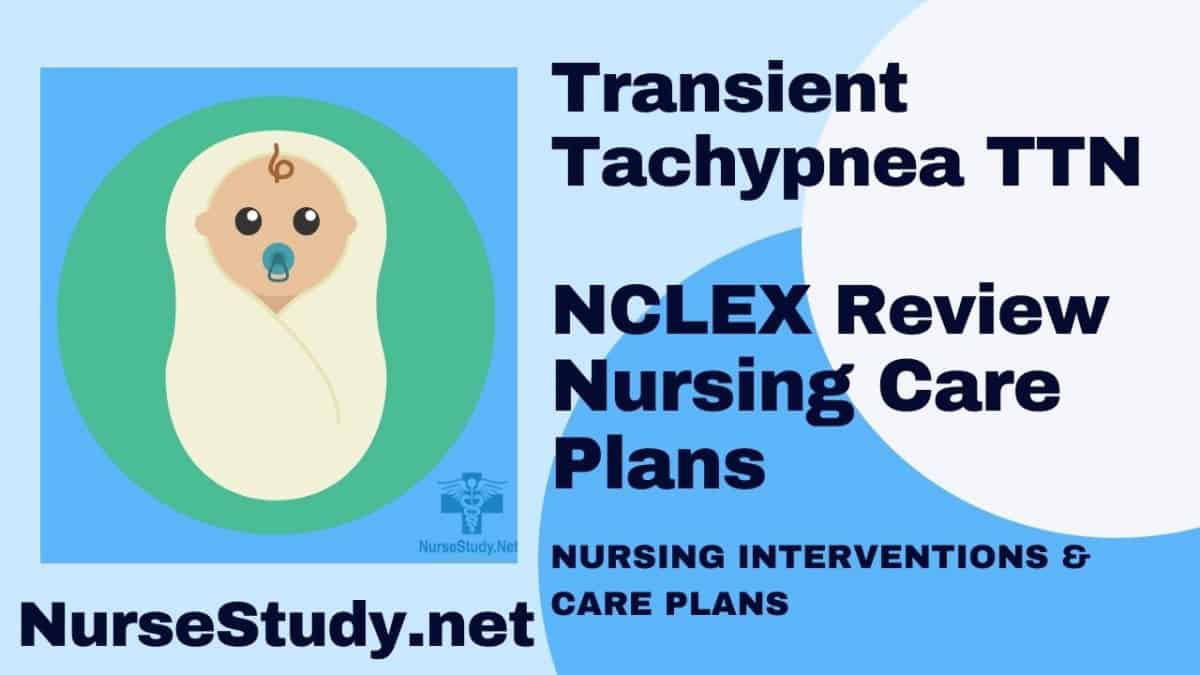Transient tachypnea of the newborn (TTN) is a temporary breathing condition that occurs shortly after birth when fluid remains in the newborn’s lungs. Transient Tachypnea nursing diagnosis focuses on identifying symptoms, providing appropriate care, and preventing complications in newborns affected by TTN.
Causes (Related to)
TTN can affect newborns due to several factors:
- Delayed clearance of fetal lung fluid
- Cesarean delivery
- Late preterm birth (34-36 weeks)
- Rapid labor and delivery
- Male gender
- Maternal asthma
- Maternal diabetes
- Macrosomia
- Low Apgar scores
Signs and Symptoms (As evidenced by)
Subjective: (Parent/Caregiver reports)
- Irritability in infant
- Feeding difficulties
- Changes in the infant’s breathing pattern
- Noisy breathing
Objective: (Nurse assesses)
- Respiratory rate >60 breaths per minute
- Nasal flaring
- Intercostal retractions
- Grunting
- Cyanosis
- Decreased oxygen saturation
- Tachycardia
- Use of accessory muscles
- Chest x-ray showing fluid in the lungs
Expected Outcomes
- Newborn will maintain respiratory rate within normal limits (40-60 breaths/minute)
- Oxygen saturation will remain >95% on room air
- No signs of respiratory distress
- Successful feeding without respiratory compromise
- Resolution of symptoms within 24-72 hours
- Normal vital signs
- Clear breath sounds
Nursing Assessment
Monitor Respiratory Status
- Assess respiratory rate, depth, and pattern
- Note work of breathing
- Monitor oxygen saturation
- Auscultate breath sounds
- Document the presence of retractions
Evaluate Cardiovascular Status
- Monitor heart rate
- Assess peripheral perfusion
- Check for cyanosis
- Monitor blood pressure
- Observe skin color
Assess Feeding Patterns
- Monitor sucking and swallowing coordination
- Assess feeding tolerance
- Document intake and output
- Note signs of fatigue during feeding
Check for Complications
- Monitor for signs of deterioration
- Assess for increasing oxygen needs
- Watch for signs of sepsis
- Monitor temperature stability
- Observe activity level
Review Risk Factors
- Assess birth history
- Document maternal risk factors
- Note delivery method
- Review Apgar scores
- Check gestational age
Nursing Care Plans
Nursing Care Plan 1: Ineffective Breathing Pattern
Nursing Diagnosis Statement:
Ineffective Breathing Pattern related to retained fetal lung fluid as evidenced by tachypnea >60 breaths per minute and intercostal retractions.
Related Factors:
- Retained fetal lung fluid
- Immature lung development
- Delayed fluid absorption
- Birth-related stress
Nursing Interventions and Rationales:
- Monitor respiratory rate and effort
Rationale: Early detection of respiratory deterioration - Position the newborn with the head elevated 30-45 degrees
Rationale: Promotes optimal lung expansion - Provide supplemental oxygen as ordered
Rationale: Maintains adequate oxygenation
Desired Outcomes:
- Respiratory rate will return to normal range
- Work of breathing will decrease
- Oxygen saturation will remain >95%
Nursing Care Plan 2: Risk for Impaired Gas Exchange
Nursing Diagnosis Statement:
Risk for Impaired Gas Exchange related to ventilation-perfusion mismatch secondary to retained lung fluid.
Related Factors:
- Fluid in alveoli
- Increased work of breathing
- Respiratory fatigue
- Altered oxygen delivery
Nursing Interventions and Rationales:
- Monitor oxygen saturation continuously
Rationale: Ensures adequate oxygenation - Assess breath sounds every 2-4 hours
Rationale: Identifies improvement or deterioration - Document color changes and work of breathing
Rationale: Indicates effectiveness of gas exchange
Desired Outcomes:
- Maintain oxygen saturation >95%
- Demonstrate pink skin color
- Show decreased work of breathing
Nursing Care Plan 3: Risk for Ineffective Thermoregulation
Nursing Diagnosis Statement:
Risk for Ineffective Thermoregulation related to increased energy expenditure from respiratory distress.
Related Factors:
- Increased metabolic demands
- Respiratory distress
- Environmental factors
- Limited energy reserves
Nursing Interventions and Rationales:
- Monitor axillary temperature q4h
Rationale: Identifies temperature instability - Maintain a neutral thermal environment
Rationale: Prevents cold stress - Minimize handling during care
Rationale: Reduces energy expenditure
Desired Outcomes:
- Maintain temperature between 36.5-37.5°C
- Demonstrate stable vital signs
- Show appropriate activity level
Nursing Care Plan 4: Ineffective Feeding Pattern
Nursing Diagnosis Statement:
Ineffective Feeding Pattern related to respiratory distress as evidenced by poor feeding coordination.
Related Factors:
- Increased work of breathing
- Fatigue
- Poor suck-swallow coordination
- Respiratory distress
Nursing Interventions and Rationales:
- Assess feeding readiness
Rationale: Ensures safe feeding - Monitor feeding tolerance
Rationale: Prevents aspiration - Coordinate care with feeding times
Rationale: Conserves energy
Desired Outcomes:
- Demonstrate effective feeding pattern
- Maintain adequate hydration
- Show appropriate weight gain
Nursing Care Plan 5: Anxiety (Parents)
Nursing Diagnosis Statement:
Anxiety related to the infant’s health status as evidenced by expressed concerns and questions about prognosis.
Related Factors:
- Uncertain prognosis
- Unfamiliar environment
- Separation from infant
- Limited understanding of the condition
Nursing Interventions and Rationales:
- Provide education about TTN
Rationale: Increases understanding and reduces anxiety - Encourage parent participation in care
Rationale: Promotes bonding and confidence - Update parents regularly on the infant’s progress
Rationale: Maintains communication and trust
Desired Outcomes:
- Parents will verbalize understanding of the condition
- Parents will demonstrate appropriate care techniques
- Parents will report decreased anxiety levels
References
- Alhassen Z, Vali P, Guglani L, Lakshminrusimha S, Ryan RM. Recent Advances in Pathophysiology and Management of Transient Tachypnea of Newborn. J Perinatol. 2021 Jan;41(1):6-16. doi: 10.1038/s41372-020-0757-3. Epub 2020 Aug 4. PMID: 32753712.
- Hermansen CL, Lorah KN. Respiratory distress in the newborn. Am Fam Physician. 2007 Oct 1;76(7):987-94. PMID: 17956068.
- Moresco L, Bruschettini M, Cohen A, Gaiero A, Calevo MG. Salbutamol for transient tachypnea of the newborn. Cochrane Database Syst Rev. 2016 May 23;(5):CD011878. doi: 10.1002/14651858.CD011878.pub2. Update in: Cochrane Database Syst Rev. 2021 Feb 5;2:CD011878. doi: 10.1002/14651858.CD011878.pub3. PMID: 27210618.
- Reuter S, Moser C, Baack M. Respiratory distress in the newborn. Pediatr Rev. 2014 Oct;35(10):417-28; quiz 429. doi: 10.1542/pir.35-10-417. PMID: 25274969; PMCID: PMC4533247.
